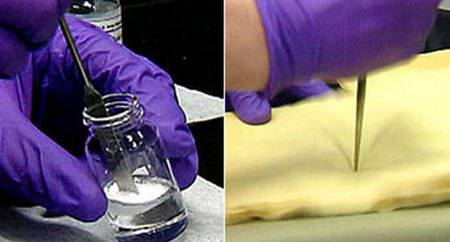Future Technologies - Liquid Armor
These types of body armor were informally called “liquid armor” and work on their development is carried out in parallel in both Russia and the United States. In Russia, the development of "liquid armor" is already in 2006, led by the Yekaterinburg Venture Fund of the MIC, and according to them, in the coming years, this product will already enter the market.

The protective gel, which forms the basis of the “liquid armor”, consists of a liquid filler and solid nanoparticles, which, when hit by a bullet or any other sharp blow, instantaneously set and turn into a solid composite material. In addition, unlike standard body armor, the force from a bullet hit in “liquid armor” does not concentrate in one place, but is distributed over the entire surface of the fabric. This allows you to significantly improve the protective characteristics of armor, as well as to avoid bruises and hematomas that remain on the body from falling into the usual lead, or Kevlar vest. It should be noted that this gel shows its characteristics only on a special fabric, the structure of which the developers carefully hide.
True at the moment, the "liquid armor" there are some drawbacks. Thus, the existing samples are able to protect only against small-caliber bullets, and a shot from an automatic rifle or a sniper rifle is almost guaranteed to penetrate “liquid armor”. Also, when water gets on the armor, it loses its protective properties by at least 40 percent, which adds additional problems to developers. However, a solution to this problem has already been found. The fabric can be placed in a moisture-proof film, or coated with a special water-repellent composition based on nanotechnology, created by our scientists five years ago.
In conclusion, I would like to say that “liquid armor” is one of the most promising technologies developed by Russian specialists in recent years. She will not only be able to reliably protect a fighter from bullets and shrapnel and give him the opportunity to move freely around the battlefield without a bulky vest, but can be used both to create new types of armored vehicles and for purely civilian purposes.
Information about the properties of the reservation was taken from the official website of the developer company www.vpkf.ru
Information